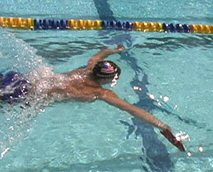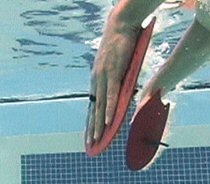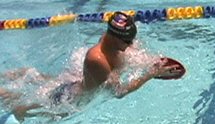|
ADVERTISEMENT
|
ADVERTISEMENT
|
|
8/13/04 BREASTSTROKE - Big Paddles
Want to feel real power in your breaststroke? Put on the biggest paddles you can
get your hands on, and start swimming. Actually, it’s not all that easy. Here’s
a drill that will help you get started.
Why Do It:
The pull in breaststroke is extremely important, and developing the proper
motion, and the feeling of power that comes with it are key ingredients to
putting together a great pull.
Using oversized paddles will automatically make you do a few things correctly.
The paddles help you feel the connection to the water during the outsweep of
the pull, and they prevent you from pulling back too far. They also make sure
that you develop a quick recovery. With big paddles, if you have an incorrect
recovery, you’ll feel MASSIVE resistance.
In order to do this properly, you need to pay attention to a few key points.
You'll notice in the first picture that Dave has removed the wrist straps from
his paddles. If he doesn’t have perfect form on every part of his pull, the
paddles will simply fall off. If you pull back too far, the paddles will fall
off when you try to recover the hands. If you start the outsweep before your
hands get turned around, the paddles will fall off.
How To Do It:
This whole drill is about fine points! It’s not for the faint at heart. Dave
makes it look SO easy, which will give you some indication of just how good he
is.
Why post such a tough drill? Well... as we finish one season, and start another,
it's always nice to have some goals with which to look forward, and to which to
aspire. Dave shows us what true mastery is all about, and how “tools,” which
sometimes get a bad rap, can teach us volumes about our stroke. Elite swimmers
use paddles, kickboards, and pull-buoys all the time. The difference between
them and the rest of us, however, is that they KNOW how to use them
effectively. By practicing this drill, and doing it absolutely correctly,
you’ll be able to make major improvements n your breaststroke. |
||||||||||







